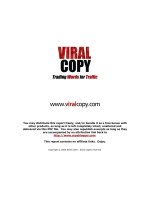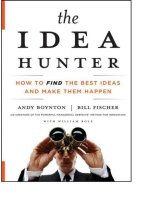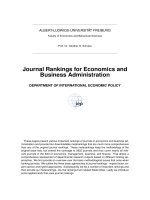People planet profit how to embrace sustainability for innovation and business growth
Bạn đang xem bản rút gọn của tài liệu. Xem và tải ngay bản đầy đủ của tài liệu tại đây (2.46 MB, 241 trang )
i
People, Planet, Profit
ii
iii
People, Planet, Profit
How to embrace sustainability for
innovation and business growth
Peter Fisk
iv
Publisher’s note
Every possible effort has been made to ensure that the information contained in this book is
accurate at the time of going to press, and the publishers and author cannot accept responsibility for any errors or omissions, however caused. No responsibility for loss or damage occasioned to any person acting, or refraining from action, as a result of the material in this
publication can be accepted by the editor, the publisher or the author.
First published in Great Britain and the United States in 2010 by Kogan Page Limited
Apart from any fair dealing for the purposes of research or private study, or criticism or review,
as permitted under the Copyright, Designs and Patents Act 1988, this publication may only be
reproduced, stored or transmitted, in any form or by any means, with the prior permission in
writing of the publishers, or in the case of reprographic reproduction in accordance with the
terms and licences issued by the CLA. Enquiries concerning reproduction outside these terms
should be sent to the publishers at the undermentioned addresses:
525 South 4th Street, #241
120 Pentonville Road
London N1 9JN
Philadelphia PA 19147
United Kingdom
USA
www.koganpage.com
4737/23 Ansari Road
Daryaganj
New Delhi 110002
India
© Peter Fisk, 2010
The right of Peter Fisk to be identified as the author of this work has been asserted by him in
accordance with the Copyright, Designs and Patents Act 1988.
‘LEED’ and related logo is a trademark owned by the U.S. Green Building Council and is used
by permission.
FSC logo © 1996 Forest Stewardship Council A.C.
The FAIRTRADE Mark reproduced with kind permission of the Fairtrade Foundation.
This book was produced using sustainable materials and printed on 100% recycled paper with
no environmentally damaging chemicals used for bleaching.
978 0 7494 5411 1
ISBN
E-ISBN 978 0 7494 5863 8
British Library Cataloguing-in-Publication Data
A CIP record for this book is available from the British Library.
Library of Congress Cataloging-in-Publication Data
Fisk, Peter (Peter Robert)
People, planet, profit : how to embrace sustainability for innovation and business growth /
Peter Fisk.
p. cm.
Includes index.
ISBN 978-0-7494-5411-1 -- ISBN 978-0-7494-5863-8 1. Social responsibility of business.
2. Industrial management--Environmental aspects. 3. Corporations--Growth. 4. Social responsibility of business--Case studies. 5. Industrial management--Environmental aspects--Case
studies. 6. Corporations--Growth--Case studies. I. Title.
HD60.F535 2010
658.4’083--dc22
2009048339
Typeset by Saxon Graphics Ltd, Derby
Printed and bound in Great Britain by MPG Books Ltd, Bodmin, Cornwall
v
For Anna and Clara
vi
vii
Contents
Introduction: People and Planet and Profit
The People, Planet, Profit Manifesto
Part 1: Rethinking business
1
10
13
My world: Kris, the Indian computer engineer
My world: Claire the South African banker
My world: Grant, the American entrepreneur
14
15
16
1.
Purpose beyond profits
Making people’s lives better
Defining an inspiring purpose
Turning promises into reality
Google and Microsoft: finding purpose in a digital world
People, planet, profit: the reality of purpose
17
19
21
24
26
30
2.
Strategies for growth
Finding markets with sustainable growth
Creating differentiation by doing good
New business models for a new business world
Apple and Nokia: being cool in a caring world
People, planet, profit: the reality of strategy
36
39
42
43
45
49
3.
Inspiring leadership
Leaders of the new business world
Leaders as the catalysts of change
What it means personally
56
58
61
62
viii Contents
Patagonia and Timberland: reaching new heights
People, planet, profit: the reality of leadership
Part 2: Reconnecting business
64
67
71
My world: Sugito, the Japanese salesman
My world: Ash, the young Singapore journalist
My world: Summerly, the London art gallery owner
72
73
74
4.
Conscience consumers
Enabling people to be good
The new consumer agenda
Segmenting the conscience consumers
Coca-Cola and Danone: seeing a different side of life
People, planet, profit: the reality of consumers
75
78
81
82
85
89
5.
Sustainable innovation
Social and environmental drivers of innovation
Innovating every aspect of business
The creative potential of social entrepreneurs
Amazon and eBay: redefining markets through innovation
People, planet, profit: the reality of innovation
91
94
97
99
102
104
6.
Engaging consumers
Engaging people through enlightened dialogue
Building networks to do more together
The ‘good’ consumer experience
Marks & Spencer and Wal-Mart: retail revolutionaries
People, planet, profit: the reality of engagement
109
111
113
116
118
122
Part 3: Releasing business
7.
127
My world: Biki, the Barcelona mother
My world: Stuart, the London advertising exec
My world: Nicky, the Hong Kong banker
128
129
130
Sustainable operations
Working better together
Good sourcing, transporting and producing
The power of sustainable energy and technologies
Adidas and Nike: no finish line
People, planet, profit: the reality of operations
131
132
134
137
138
141
Contents ix
8.
Delivering performance
Certification, labels and sustainable impacts
Linking sustainability to business results
Managing business performance and reputation
News Corporation and Time Warner: beyond print
People, planet, profit: the reality of performance
145
147
153
156
158
163
9.
Transforming business
Making sustainable change happen
Articulating the case for change
Managing the implementation
Ikea and Interface: good living
People, planet, profit: the reality of transformation
166
168
170
171
174
178
10.
Emerging futures
Leading in the new business world
Sustainable innovation and lifestyles
Business as a force for positive change
182
184
187
194
Part4: Resources
197
The People, Planet, Profit A to Z
The People, Planet, Profit blueprint
The People, Planet, Profit directory
The People, Planet, Profit programme
198
204
204
210
Authors and contributors
212
Index
218
x
1
Introduction:
People and Planet
and Profit
2 People, planet, profit
We live in a time of unprecedented change.
In business we face challenges and opportunities that are more critical and
complex than ever – where the consequences of failure are unimaginable
and the impact of our decisions is felt instantly across the planet.
A fragile economy and a climate out of control, poverty across half the
planet and scarcity of natural resources, the extinction of species and explosion in population, ethical dilemmas on every corner, and low confidence
and trust in business: symptoms of a changing world.
Change is all around us: the cries for help at the end of an industrial age,
the shift in power towards the developing world, from big to small, masses to
niches, and the recognition that we can only sustain our livelihoods with new
thinking, new behaviours and new balances.
We know that the old short-term, sales- and wealth-obsessed models of business are broken, and we are now beginning to feel the consequences. We
struggle to balance our priorities and ambitions – the pursuit of personal and
business success, whilst also seeking to make the world a better place. Is it
possible to do both?
These are challenging times to lead and manage a business, even more
difficult to create and sustain profitable growth.
Rethink
Social and environmental issues are more important than ever. For business,
they represent some of the greatest opportunities to find new markets of
profitable growth, more lasting and engaging sources of competitive advantage, and more effective ways to reduce cost and risk.
Consumers no longer feel conflicted by the issues, but are committed to
supporting change. Doing good is no longer about sackcloth and frugality, it
can feel and taste good too. We realize that it is no longer a nice-to-have, but
a must-do. We realize that it is no longer a peripheral activity but fundamental to every aspect of how we do business, every day, for everyone.
People, Planet, Profit is about business opportunity, operational improvement
and competitive advantage. It is a practical handbook for CEOs and business
managers who are searching for new ways to create value, to make sense of
business in a rapidly shifting landscape, to deliver profitable growth whilst
also doing ‘the right thing’. It is about:
Profitable growth: finding new ways to sustain growth in a world that is
changing rapidly, and can seem threatening and uncertain;
• Innovation: positively connecting capitalism and environmentalism,
realigning issues and incentives, and making business a force for good;
•
Introduction 3
Competitive advantage: putting social and environmental impacts at the
heart of your business, the basis of more engaging differentiation;
• Leadership: inspiring business to be the creators of this new world – to
rethink, reframe and reinvent your business for a better future.
•
This is not really a book about sustainability in itself, about the world’s problems, or about ‘being green’. The last thing business needs is another dysfunctional strategy, more complex initiatives and distraction. Social and
environmental issues should be at the core of a business strategy, leveraged as
the best sources of improving efficiency and driving innovation, working with
partners in new ways whilst also finding a more lasting difference, and a better
way to engage people.
People, Planet, Profit is about inspiring leadership, more radical innovation
and sustaining performance in the new business world.
Can business growth be good?
Of course, the world faces immense problems, so great that few organizations
have the power or scale to solve them.
Business is unique in this sense. Through engaging brands and thoughtful
innovation it can mobilize consumers to change behaviour in positive ways.
By adapting the resources it uses and the ways it works, it can make a huge
difference to the environment. It can be a powerful force of positive
change.
There is no paradox or conflict, as some suggest. Business really can grow
and be good.
People, planet and profit are not alternative goals, or a compromise result.
A positive impact on people and planet can be achieved whilst also delivering
profitable growth.
Indeed, a positive impact on people and planet is increasingly becoming
the best source of profitable growth.
Despite a rapidly increasing global population and carbon emissions that
threaten the air we breathe, it is possible to continue to grow economically
and replenish the resources we use. Of course, it is likely to be a different sort
of growth. It will be less about volume, more about profit; less materialistic
production and more about supportive services, less self-indulgent and more
about enabling people to live better lives.
Whilst the importance of social and environmental issues might seem
obvious, they are not always seen as key to business success. Indeed, waves of
restrictive legislation and anti-capitalist lobbying can put them in conflict.
This is because we haven’t seen the connections.
4 People, planet, profit
However, as Ben Clarke from Kraft Foods says, ‘Sustainability is now about
profit… it is the opportunity of the 21st century.’
The business case for people and planet and profit is based on both the
profitable new opportunities of sustainable markets – embracing these issues
within existing markets, and investing in new market spaces such as renewable energies – and also on the significant cost and risks likely to be incurred
by unsustainable practices in future.
These growth opportunities are rapidly being embraced; the gold rush is
on. Venture capitalists and entrepreneurs are now firmly focused on sustainable markets. Similarly the costs and risks are already hitting balance sheets.
Investors are penalizing ‘dirty’ companies for their vulnerable future cash
flows, and finance managers are calculating their liabilities.
The consequences of not changing are not just for the world we leave
behind for our children, but more immediately through the liabilities of
increasing financial penalties imposed by governments (for example, taxation on transport and industrial emissions), by supply chains, and ultimately
by consumers (for example, the prohibitive cost of insurance in areas vulnerable to extreme weather).
Sustainability is no longer an adjunct to business. It is no longer a separate
department, or even a team within the corporate affairs department
concerned only about compliance and reputation. It is no longer enough to
have some worthy goals, a sustainability strategy as an appendix to the business plan, or a sustainability report as an afterthought.
CSR (corporate social responsibility) strategies were typically peripheral
compensation for the damages already done, relieving the guilt of companies
that couldn’t see the light. They were the clean, caring icing on the big dirty
cake. They sought to protect superficial and increasingly fragile reputations.
‘People and planet and profit’ is much more than that. It is about moving
the issues of sustainability from the fringes to the heart of business. It demands
that business leaders rethink fundamental strategic questions: why we exist,
where we should focus, how we are different, and why people will choose a
product, want to work for us and invest in our business.
People and planet
The social and environmental challenges are known and numerous. But
with rethinking they also represent some of the best opportunities for
business.
Consider just some of them. As the global population mushrooms towards
9 million, cities like Beijing, Los Angeles and Mumbai will triple in size.
Introduction 5
1950s – 60s
Awakening
• Industrial growth
delivers wealth and
expectation
• Western markets
thrive whilst the
East recovers
more slowly
• Migration to cities
accelerated by
travel and
employment
• Flower-power
hippies raise social
and environment
priorities
1970s – 80s
Regulating
1990s – 00s
Contributing
2010+
Transforming
• Economic growth
with increased
consumerism and
international trade
• Multinational
brands serve more
diverse, informed
and conscious
customers
• Global markets,
with instant
connectivity, global
trends and rising
‘base of the
pyramid’
• Product innovation
supported by
low-cost
automated
production
• Improved lifestyles,
human and equal
rights lead to new
practices
• Government
regulation on
pollution and waste
through taxation
• Digital innovation
creates virtual
businesses, faster
and more
connected
• Corporate
governance
improves the
ethical and social
behaviour of
business
• Recycling,
sustainable
sourcing and
disposal adopted
as standard
• Sustainable
innovation puts
social and
environmental
issues at core of
business
• Collaborative
organizations and
networked
communities for
new business
models
• Sustainable
markets are most
profitable, as
‘doing good’
becomes the best
way to grow
Figure 0.1 Sustainable agenda: how social and environmental issues have
moved from the organization fringes to core business
Whilst the global middle class is the fastest growing section of society, with its
high aspirations and higher consumption, a billion people survive on less
than $1 a day, 3 billion on less than $2 a day.
Three billion people have no access to clean water, 800 million are hungry,
and 10 million children die before they are five.
Yet those at the bottom of the pyramid have dreams too. They seek better
lives and demand more. Together they represent an estimated $5 trillion
market.
Add to this the environmental challenges. Every year we destroy 44 million
acres of forest, creating an increasing imbalance in the way nature produces
and absorbs carbon dioxide. We lose 100 million acres of farmland, cutting
down trees, diverting natural irrigation and creating 15 million acres of new
desert around the world. We emit 8 billion tonnes of carbon into our atmosphere, only 3 billion tonnes of which can be reabsorbed. We use 160 billion
1900
1900
1800
1900
(% decline in rainforests and
woodlands)
Deforestation
1800
(cubic km per year)
Water consumption
1800
(global people, billions)
Population
2000
2000
2000
280
300
320
340
360
50
100
150
200
250
10
20
30
40
2000
2000
1800
1900
2000
(carbon dioxide in atmosphere, ppmv)
1900
Carbon emissions
1800
(tons, millions)
1900
Paper consumption
1800
(global GDP, $trillions)
Economic wealth
10
20
30
200
400
600
800
100
200
300
400
500
1900
1800
1900
(extinct species, thousands)
Biodiversity
1800
(cars, millions)
1900
Transport consumption
1800
2000
2000
2000
(foreign direct investment, $billions)
Globalization
Figure 0.2 World changing: 250 years of population, economic and consumption growth, and the
impacts on our environment (sources: WEF, WWF, New Scientist)
10
20
30
2
4
6
1
2
3
4
5
6
7
Introduction 7
tons more water each year than is being replenished by rain, enough to
require a 450,000 km convoy of trucks.
As a result of this damage, 200 million people will become refugees due to
flooding and drought if the climate warms by 2–3 degrees by 2050. Financially, insurance claims will increase by $320 billion due to storms and floods,
if carbon emissions continue to rise at present rates – making insurance
premiums too expensive for most individuals or companies. The deforestation will reduce crop yields across Africa by 33 per cent, adding to the hunger.
And a five-metre rise in sea levels, caused by melting polar ice caps, will wipe
out many coastal areas, with consequences that include a predicted 11 per
cent decline in China’s GDP.
‘In a world where the ideology of free enterprise has no real challenges,
why have free markets failed so many people?’ questions Nobel Prize-winning
economist Muhammad Yunus, arguing that ‘Instead they exacerbate poverty,
disease, pollution, corruption, crime and inequality.’
Challenges and opportunity
The challenges are complex and connected. Whilst we seek to reverse climate
change, conserve water and relieve poverty, we also care about issues such as
human rights, fair trade and supporting our local communities. Whilst we
seek to act more ethically and responsibly, we also care about our own well
being and happiness.
Green is not enough. It requires a more joined-up approach. It requires
business to do more than improve, but also to think differently, to change its
game.
Maybe blue is a better colour.
The new business world demands ‘blue sky’ thinking, ideas that open up
new ‘blue oceans’ of opportunity and redraw the blueprints for business practice.
It is not just about ‘reducing, recycling and reusing’, as the mantra goes. It
is about rethinking.
Climate change is most effectively addressed by rethinking and redefining
the resources we use, rather than seeking to limit the damage by belatedly
planting a few more trees. Similarly, in business it is not about product
enhancements and campaigns that jump on the bandwagon. People quickly
see through the greenwash, demanding real transparency in return for
trust.
Business needs to address its economic, social and environmental challenges holistically, and to understand how they can combine as positive forces
in creating a better world.
8 People, planet, profit
an
Hum ts
righ
Rep
le
res nishin
our
ces g
Living within
environmental
limits
Em
and ission
poll s
utio
n
End
disp of life
osa
l
Bui
ld
des ing
ign
Rel
ie
pov ving
erty
Priv
ac
equ y and
ality
ble
ewa
Ren nergy
e
d
s an
istic rt
Log anspo
tr
Saf
et
sec y and
urit
y
ing
tain
Sus ersity
div
and
e
ics
Eth rnanc
e
gov
Ensuring a
fair
society
d
Goo yer
plo
m
e
and
on nt
e
cati
Edu elopm
dev
Loc
com ality a
mu nd
nitie
s
Ent
e
par rprise
tne
rs
s
ines
Bus del
mo
Creating a
sustainable
business
Cre
at
inno ivity a
vati nd
on
nd
lth a
Hea llbeing
we
Pro
fit
gro able
wth
stor
Inve rns
retu
Eff
pro icient
ces
ses
itive
pet e
Com antag
adv
ste
Wa ement
nag
a
m
Figure 0.3 People and planet and profit: economic growth is only sustain
able if business activities are integrated with social and environmental priorities (source: Genius Works)
‘People and planet and profit’ is a more connected approach to business. It
demands systems thinking, seeing the bigger picture of why and how we work.
It will require us to reject many of the conventions and conveniences of business that created past success; taking new perspectives, finding new solutions,
and even finding new measures of performance.
It requires us to reconnect with consumers who have lost faith, suppliers
who feel beaten up, and sometimes even with competitors where together we
can have more impact.
Inspired leaders
It demands the vision and courage of business leaders, and every manager
across the organization, to release business from the shadows of a failing
Introduction 9
world, to realize a new spirit of entrepreneurship and innovation through
which we and others can prosper.
Crisis is the prelude to change. Whilst some see change as a threat, others
seize the new opportunities. If we look to the East, perhaps to learn a new
language as well as find new markets, we would find that the same character
in Chinese script represents both the concept of threat and that of opportunity.
Welcome to the dawn of a new business world.
It’s time to think and act differently.
10 People, planet, profit
The People, Planet, Profit Manifesto
Leaders of business, this is your wake-up call.
You’ve been living on borrowed time.
Raping the natural world of its resources, and leaving a toxic mess in
its place.
These weather patterns are not freaks, they are the world you have
created.
Blinding the man on the street with your superficial innovations and
image.
What about the sweatshops, the emissions, the packaging, the greed?
It doesn’t look good.
Business, society and nature need to find a new way to coexist.
If you aren’t sustainable, you are irresponsible.
It’s time to adapt or suffer the consequences.
The business world is about to go through a rapid, fundamental
change.
What an opportunity, but also what a threat.
It’s time to rethink.
Time to stop living in the past, and think of our future.
Business is not a machine, it’s a dynamic system – it lives, adapts and
grows.
You need to think again about what is a cost and a risk, and what really
creates value in the world today.
But it will take a lot more than reducing, recycling and reusing.
It requires a fundamental rethink, radically and creatively.
Rethink your business purpose and strategy.
Rethink your processes and technologies.
Rethink your markets and audiences.
Imagine that you are looking at a piece of impressionist art. Short
term, too close, you are blinded by millions of dots; stand back and you
see a bigger vision.
The environment is not a commodity, and people are not disposable.
Introduction 11
New legal codes and financial penalties will protect them.
But this is not just about compliance. It’s much more than CSR.
It goes to the heart of business. To why you exist.
Where you focus, how you succeed.
To connect business and the world in new ways.
People and planet and profit. Together, achieving more.
Business is a societal good. It has a responsibility beyond itself.
Brands and consumerism, profits and wealth can be incentives for
change.
Available to anyone, the benefits shared by everyone.
Be brave. Seek out ideas beyond your comfort zone.
Create a new language of sustainability that transcends traditional
disciplines.
Redefine stakeholders more broadly.
Everything is possible. Nothing is off limits.
From nuclear energy to GM foods, we need to rethink our prejudices
too.
Collaborate with your competitors, and even your fiercest critics.
Work with governments and activists to explore new solutions.
Together we can do so much more.
We need innovation to find new ways to overcome conflicting priorities, to make inspired choices, to find brilliant new balances.
Sustainability is about creating a more lasting and fairer world.
Where we can work and play, laugh and smile.
And our children will be able to too.
Grow by putting our future at the heart of your business.
Grow better by being and doing good as a business.
Be bold and brilliant.
Be the change.
12
13
Part 1
Rethinking business
‘Be the change,’ said Mahatma Gandhi.
14 People, planet, profit
My world: Kris, the Indian computer engineer
Kris is 34, married with three children, and works for one of the world’s fastestgrowing technology companies, based in the Indian high-tech metropolis of
Bangalore. He previously studied for an engineering degree in London and
MBA in Boston.
He recognizes that he has done well in an emerging country of many extremes
– religion and history, poverty and wealth. ‘India has one of the fastest-growing
middle classes, where families like mine have many of the trappings of Western
lifestyle. We have satellite TV and a 4×4 Toyota car. We go to the cinema, and
next year hope to take our children to Disneyland.’
But he has not lost touch with the masses of Indians who still live in relative poverty, with few material goods and limited ambitions in life. ‘My
parents, my two brothers and both of their families all live in a small house
near to Mumbai. They earn little money, working in factories and in construction. Their need to earn money has meant they have never trained for any
specific job, and what I find saddest is that they have limited ambition. They
live for today.’
Kris is increasingly aware of the social and environmental challenges his
country faces. Whilst the Asian tsunami of 2005 dramatically raised awareness
of the perils of a changing climate, he is much more concerned about improving the quality of life of his fellow citizens. ‘We need to sort out the most
urgent issues first, the ones that directly affect people.’
He spends some time doing voluntary work with his children’s school, but
thinks that he can make a bigger difference by encouraging his business to do
more for local communities – supporting local charities, encouraging local
businesses and using the skills and solutions of his employees for non-profit
initiatives, as well as for their core business purpose.
‘Whilst the world is more joined up, I think we are still very different. As
Indian companies become respected for their quality and innovation I see
the opportunity to do much more. Not just to become wealthy, but to use
our know-how to support our country in solving its problems, and to improve
the lives of everyone. I see business, and particularly high technology companies, as very important in creating a better future for my family and my
country.’









